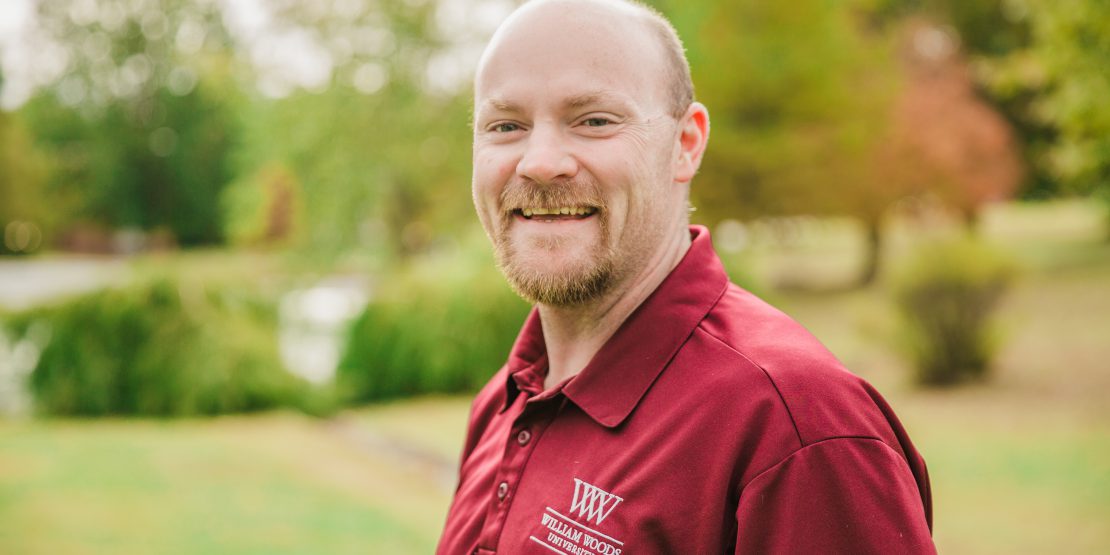Dr. Timothy Hanrahan
Assistant Professor, Physical Education; Division of Education, Human Performance, and Humanities Chair
Expertise: Health and Physical Education, Classroom Management, Educational Administration K-12, and Measurement and Assessment
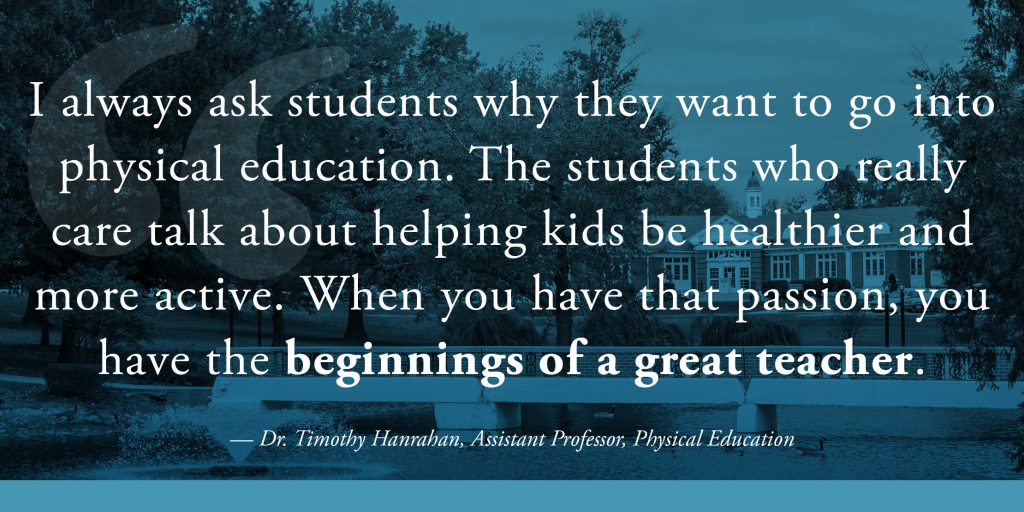
Learning from the Gridiron
Football helped me become the person I am today. I was born and raised in St. Louis, Mo., before moving to Kansas City, Mo. My mom was a Catholic school teacher and principal and my dad was a police officer. We spent a lot of time being involved with athletics. I played football (nose tackle) and it had a great impact on my list. I learned how to work really hard, how to be part of a group, and how to sacrifice. That’s the one thing I always tell my students about sports: It teaches you how to be a part of something bigger than you and how to commit to something in order to benefit everyone else.
After high school, I was recruited to a few D2/D3 colleges. I ended up at Truman State University and decided to let football go and focus on other aspects of life.
I decided to major in exercise science, with a concentration in health and physical education. I ended up helping with the university’s coaching group for a while, as well as teaching homeschool physical education and giving swim lessons and figured I had found my path: being a teacher and coach.
Coach vs. Teacher
Initially, coaching football is all I wanted to do. But when I started looking for opportunities after college, there were more elementary jobs available. So, I jumped in. My first job was as a math and reading Title I instructor aide at an elementary school in Kansas City. It was the only job opening the school had, so I took it. And ended up having a lot of fun. I worked one-on-one with kids who were struggling with math, science, and reading.
Eventually, I earned certifications in physical education K-12 and health education K-12, and my master’s degree in education from the University of Central Missouri.
I started working as a physical education teacher in the Columbia Public School system in Columbia, Mo., and I absolutely loved it. I was working with kids who really wanted to be there. In the afternoons, I was also an assistant coach for Oakland Junior High School’s football team.
In my career, I’ve taught students from K-12. And I’ve loved it all. I love how passionate the younger students are because they want to be there and it’s fun for them. The older the students, the more it flips. It’s harder to get older students engaged and to buy into what you’re doing. But once you get there, you can do some really fun things with them and they remember you for being a great teacher.
From Mentor to Professor
After five years of teaching P.E., I had developed a reputation as a good teacher in the school system. I was asked to start mentoring first and second year P.E. teachers. I would work with them for a few years, observe them in the classroom, offer feedback, and try to help them become better teachers. I really enjoyed this experience. At the time, my mom was working as a consultant, helping schools and teachers that were struggling, and I would assist her during the summers.
I enjoyed being a mentor to other teachers because I am really passionate about the science of lesson design and delivery, and this offered me the opportunity to help others achieve this goal.
A friend of mine was getting a master’s degree at William Woods. One day, all of a sudden, he called me to say that the university was looking for a P.E. professor. I had gotten my doctorate in Education Administration K-12 from Walden University a few years before, so I was interested in the job. And it worked out.
Rebuilding William Woods’ Physical Education Program
When I first was hired at The Woods, I was an assistant professor of physical education. My main job was to work with the P.E. students and teach a variety of courses. I was handling Activity courses, Measurement and Evaluation, Motor Learning, Methods of Elementary and Secondary P.E., Sports Psychology, etc. I had experience with these topics, but I hadn’t taught them at the college level before. It was an interesting experience to share my knowledge with students.
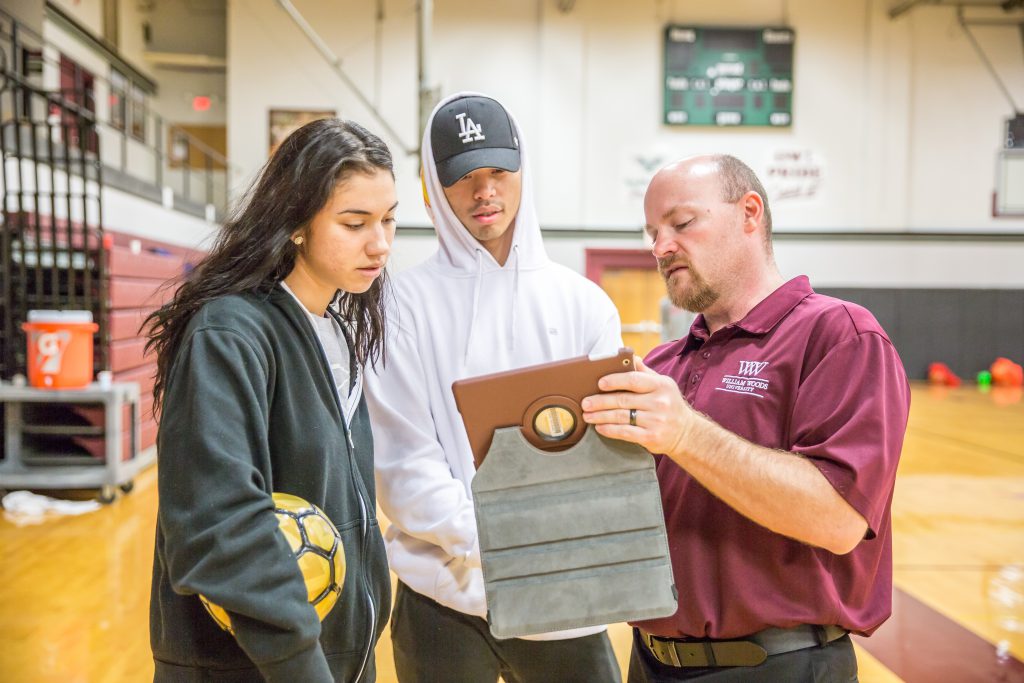
Soon after I joined the faculty, the university recognized that some of the P.E. students were struggling to pass the external assessments needed for this career. The state of Missouri was changing its requirements and the tests were getting harder. I find this area of the profession interesting, so I offered to help out. I worked on the program’s curriculum with a focus on testing and how our students could succeed. We concentrated on what it means to be a good teacher and a good physical educator — not just a coach.
I always ask students why they want to go into physical education. You know you don’t have the right person when they say ‘I want to coach’ and make it about them. The students who really care talk about helping kids be healthier and more active. Yes, they coach and do other things, but they are there for the kids because they want to make them better.
When you have that passion, you have the beginnings of a great teacher.
We now have a 100 percent placement rate for our physical education students. These types of jobs aren’t the easiest to get because they’re so competitive. But our graduates are prepared, hired immediately, and are well respected for the knowledge they bring to schools. They’re coaching, they’re teaching, they’re getting their graduate degrees. A few alumni have even won physical education major of the year awards from the Missouri Association for Health, Physical Education, Recreation and Dance (MAHPERD).
So, You Want to Major in Physical Education
In this program, we emphasize that you have to take the first step yourself. We will help and guide you, but we are not doing it for you. When students ask a question, I ask a guiding question back.
I want to challenge them and force them to think, rather than get immediate responses.
All physical education majors start off taking specific general education classes. Then, in order to officially enter the program, they have to pass an assessment exam that looks at science, social science, math, reading, and writing. They take a combination of content courses completely focused on physical education.
My favorite class to teach is Motor Learning, which is learning the development of how kids move and grow. How do children interact with their environment? How does movement occur? What should a person who has never thrown a ball look like? What does an advanced thrower look like? How do we get them from point A to point B? A lot of our students only know the advanced; they forgot what it looks like from the beginning. We review that full progression, so they learn what it looks like at each step of the way.
I also love the Methods courses because they get me into the gym and I get to teach actual activities and content. This is one of the many points where students learn how to be physical education teachers.

Senior year involves student teaching, a very important part of the physical education curriculum. They apply everything they’ve been learning during their time at William Woods. We place them with a master physical education teacher in the area, someone with at least five years of experience and good evaluations. The student works with the instructor full-time for the entire semester (about 14 weeks), doing the same things the teacher does. We observe them in the field several times and their cooperating teacher evaluates them on a weekly basis. They receive a ton of feedback and hands-on experience. It is a very immersive process.
Once they pass their student teaching and the Missouri Pre-Service Teacher Assessment (MoPTA), they have done everything to be recommended for certification in K-12 physical education. Students then will be able to apply for teaching positions in the state of Missouri.
Physical Education Careers
Most students come into the program wanting to be a coach and high school teacher. My goal is to expose them to other possibilities. After finishing this program, our students are qualified to do it all. But in life, you have to go to where you can find a job. Smart students realize that sometimes your first job is about getting your foot in the door at a school. Once that happens, you can go anywhere. But if that means you start teaching in middle school when you really want high school, you do so.
I never expected to enjoy teaching elementary school, but I did. Some students end up really enjoying different education levels and some want to stick with high school. And it’s all okay.
We’ve also had some graduates go onto a master’s program and explore different careers, like coaching college or doing athletic administration and running a school’s entire sports program.
Testing and Trends in Physical Education
We use a lot of data in the education program here at William Woods. The faculty sit in teams and talk about our students, their testing scores and dispositions, and what makes a good teacher. We make good, solid decisions based on what we are seeing and how changes would benefit our students. When students take content assessments and general assessments, I get those scores. When they are out in the field, I observe them. Every semester, I reflect on all of those elements and how our program is doing.
One area where the program needed help was our students’ understanding of the psychological/social development of children. What do 5- and 6-year-olds understand vs. 11- and 12-year-olds? As a result, we’re incorporating new ways of teaching this topic to our majors. If we had not seen that trend in the data, we wouldn’t have known to attack the problem.
Cooperative Teaching Model
In the classroom, I’m a big fan of the cooperative teaching model, which focuses on how students can engage regularly. We interact with the material every 10–15 minutes. It could be regurgitating what I just said, thinking about it on a deeper level, creating a quick presentation about it, etc. Students work in collaborative teams of four and are always engaging with and explaining the material to each other. They are going to thoroughly understand the topics by the time they leave the room.
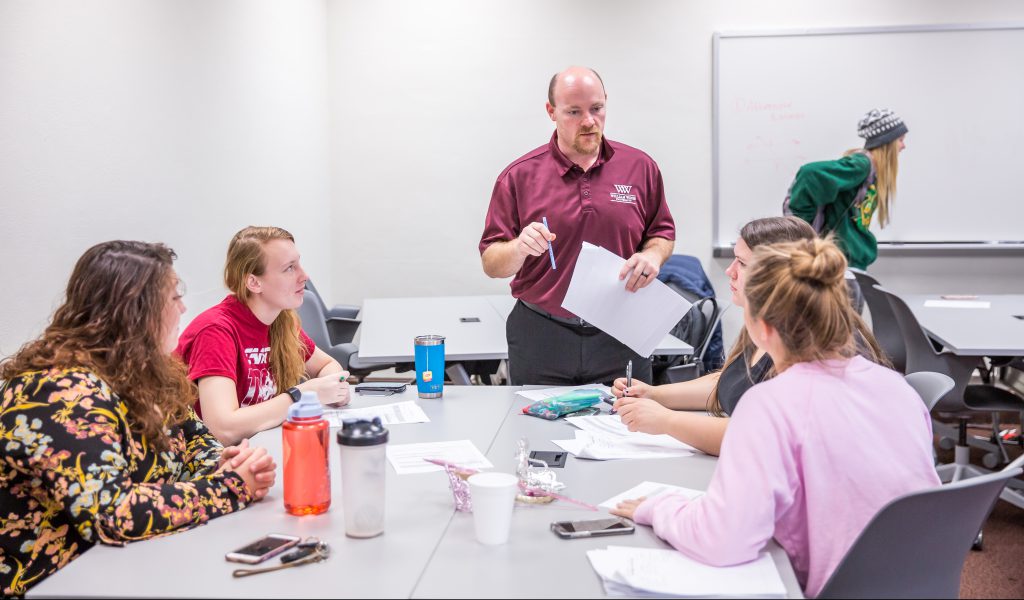
One of the first exercises I give students is a 30-second timed pair share. You have to talk to your partner about the classroom topic for the full 30 seconds. Many run out of something to say after 10 seconds — it’s not easy. We talk about the value of engaging in a conversation. How do you ask questions? Some of these things are lost in our society, which focuses so much on texting and social media. We’ve lost the interaction element. I try to teach it to them.
Now, I go into the classrooms of our alumni and they are using these techniques. It’s fantastic.
How Teachers Ask Questions
This idea of teachers asking questions is very important to me. I’m even working with a William Woods elementary education major on a Mentor-Mentee research project about it this year. We are looking at how teachers ask questions in the classroom. How are they asking the questions? At what level? Are they waiting for students to respond? Are they planning the questions ahead of time?
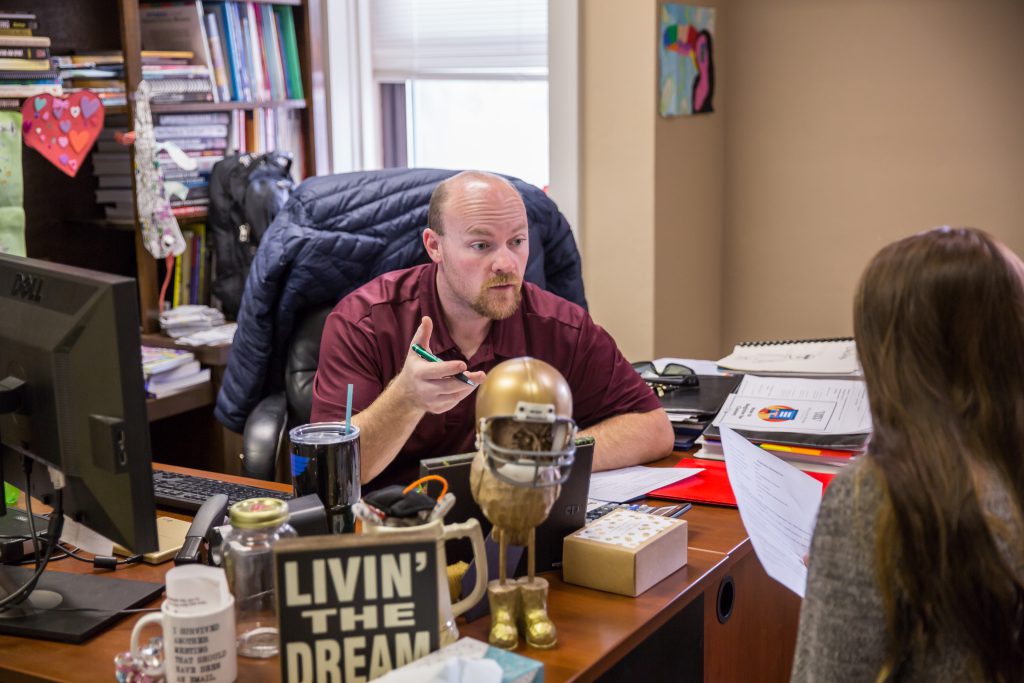
We’re collecting information on these topics to get a better sense of the practice of questioning. I want to compare physical education teachers and regular elementary education teachers to see if there is a difference in the way they plan questions or if they are even asking them at all.
Questioning can be so powerful. However, I do not think most education students and teachers examine it enough because it’s so abstract. This line of research will help us make our education program and our majors even better.
| Learn more about the William Woods Physical Education program |

